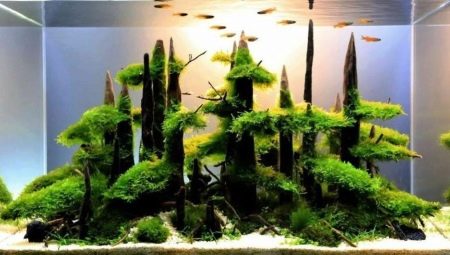Until recently, it was difficult to imagine an aquarium without a plastic or stone castle inside, as well as various imitations of possible underwater treasures. Modern design concepts give preference to naturalness, naturalness and refuse excessive decoration of the underwater space. Instead of the plastic debris of the ship, driftwood began to appear in the aquarium.
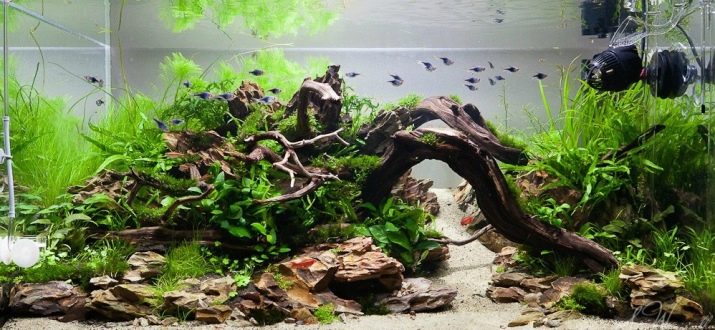
What are they for?
Natural wood and natural stone are popular materials used as decorative touches for an aquarium. Natural beauty is considered the best condition for the life of underwater inhabitants. True, aquarists have a lot of fears regarding the “behavior” of snags in the water: there is an opinion that water “blooms” from the tree, and even the fish die. You should not believe the very first panic rumors, but this issue requires detailed investigation.
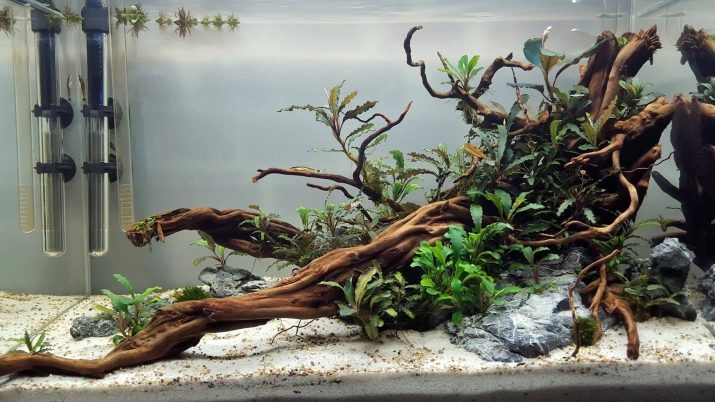
Aesthetic function prevails in determining the need for snags for the aquarium. But not only the beauty and grace of the element makes it necessary in the aquarium.
Driftwood may well serve as a means of supporting the internal ecosystem.
It is comparable to a filter and soil, since the bacteria that live on it are really significant for aquabalance. They contribute to the decomposition of organic waste into particles that can already be considered safe.
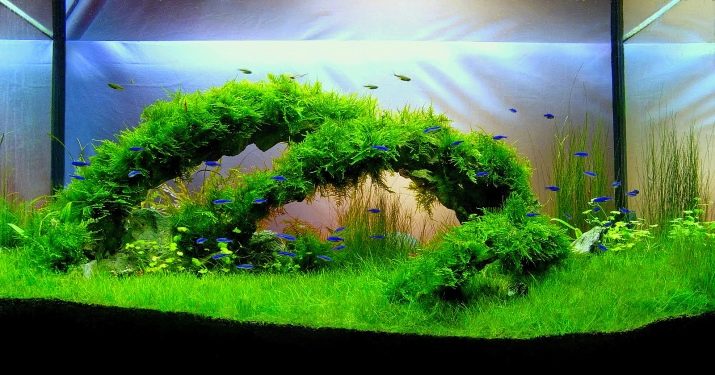
Advantages and disadvantages
Let's start with the positive. So, driftwood adorns the aquarium, has a beneficial effect on aqua balance, and besides, today it is considered a fashionable element of aquarium.
But there are other advantages of snags.
- They strengthen the immunity and health of underwater inhabitants. A tree in water releases tannins that slightly oxidize water. And this is enough for the pathogenic bacteria to stop multiplying. This process can be compared with the action of fallen leaves.
- If a regular increase in water alkalinity is recorded in the aquarium, then the driftwood introduced into the container will have a good effect on the pH balance.
- Some species of fish cannot be spawned if there are no sunken snags in the water. They lay eggs right there, in a tree, and when fry grow, snags become a shelter for kids from potential enemies.
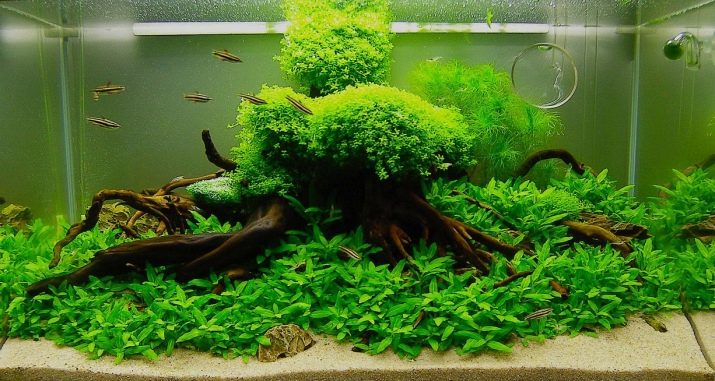
Finally, wood is becoming an additional attraction for the inhabitants of the home underwater kingdom. The design of the aquarium becomes concise, complete. You can grow beautiful plants and moss on wood.
Cons are very arbitrary - the wrong choice really negatively affects the state of the water and, consequently, the health of the fish.
Not every snag will fit into the aquarium, and especially not every snag can get there without preliminary treatment.
But for a keen aquarist, all this is not superfluous chores, but pleasant things for the benefit of a cozy and beautiful underwater world.
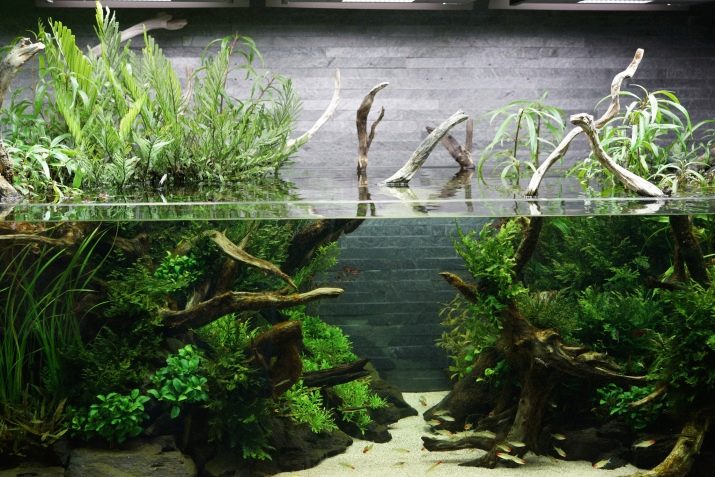
Which can be used?
A sane person, of course, will not miss any oncoming stick so that it immediately becomes the decor of the aquarium. If someone really does so under the influence of fashion, it can ruin the entire contents of the water reservoir.
Choosing the right driftwood is a serious matter. It’s easier to buy it at a pet store, because there they sell only those wood samples that are uniquely suited to the aquarium. It’s easier, though more expensive. In the pet shop, driftwood of exotic trees is sold: mangrove, mopani, sakura.
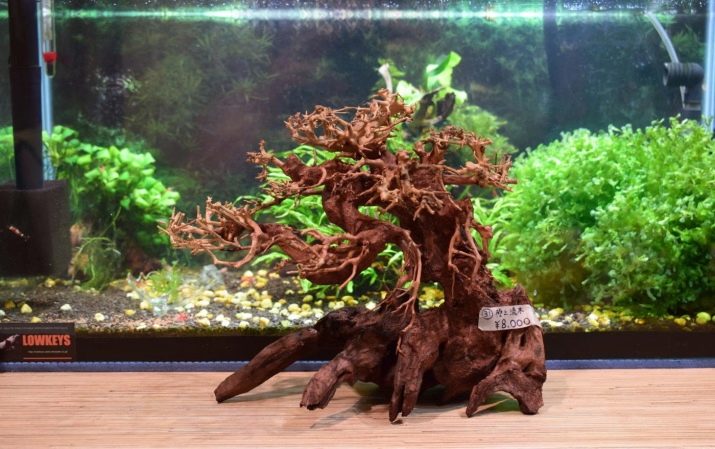
But to be honest, of course, not all assortment of pet shops can be bought. An unscrupulous seller under the guise of overseas timber can slip you something much simpler, less valuable, and most importantly – totally unacceptable in an aquarium. So, the same mangrove tree (even if it is real) colors the water quite strongly. She begins to resemble tea leaves, which scares the owner of the aquarium.
And also a significant minus of such snags - transportation. While the snag reaches the consumer, it catches certain elements harmful to the fish.
Therefore, even snags purchased in a special store will have to be carefully processed and soaked.
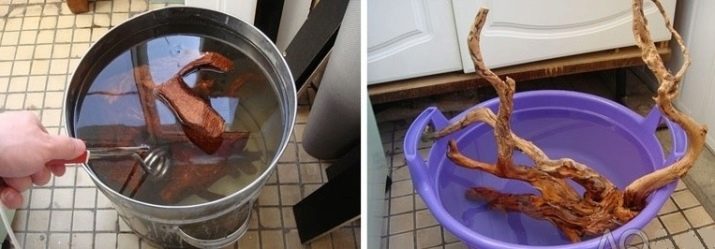
A logical question arises - why so much fuss with an ordinary piece of wood? Is it really impossible to take the oak driftwood yourself, bring it into proper form and "hook it up" in the aquarium? You can do so and it will even be safer than pulling exotic water into the water. But here you must strictly follow the rules.
- As driftwood, recessed branches, long willow roots and willow roots, as well as pears and apple trees, are suitable in the aquarium. These are solid hardwoods, which, getting into the ecosystem of the aquarium, do not violate it.
- It is strictly forbidden to place conifers in an artificial reservoir - pine, juniper and spruce. You just ruin all your underwater "hostel".
- Be sure to carefully inspect the tree. If the driftwood is very rotten and rotten, then the slightest pressure in the water will cause it to crumble in the same place. But this cannot be allowed. The wood must be solid, well, if it has grooves from worms and bugs.
- Living branches are not used. Snag must be dry. It needs to be thoroughly dried on a battery or (better) in the sun, if you want to speed up the process.
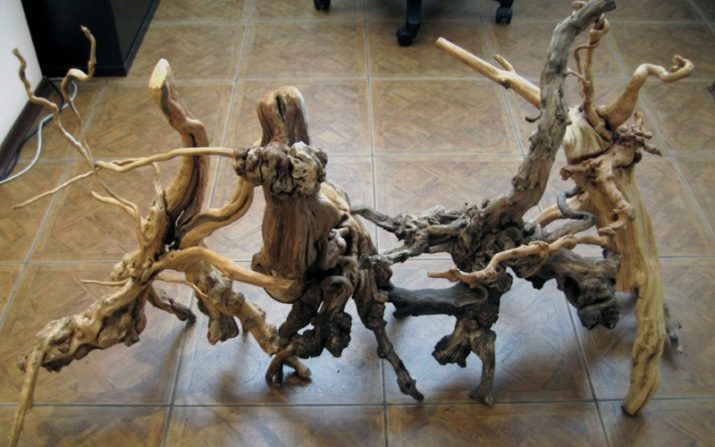
Selection recommendations
Fans of aquarium design prefer natural to artificial elements. Parts of wood that will be suitable for underwater introduction can be found anywhere: in the yard, in the park, at the bottom of a natural reservoir.
To choose the right one the first time and not to ruin the aquarium, narrow down the choice to the category of deciduous trees. The best options are pear, maple, willow, beech, apple tree, oak, grapes.
They, by the way, are the most affordable options. Decor from willow and oak, as practice shows, is most often found in an aquarium. If you take soft tree species for decoration, they will quickly decay in the water and will last you a maximum of 2 years (and it doesn’t matter – there was a small snag or a big one).
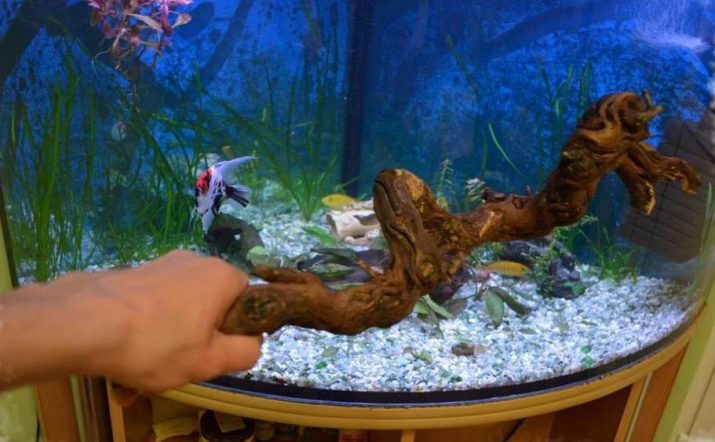
It’s absolutely impossible to use live branches.
Dry branches or tree trunks are the only acceptable underwater decor. You can cut and dry a branch that you like for decorating the bottom in a room that is well ventilated. And in the summer, it is better to dry the tree in the sun: so you definitely will not allow rotting of the wood, and ultraviolet light will save the tree from all harmful microbes.
What kind of driftwood to choose depends on personal taste. Large and textured elements look, of course, brighter. Aqua designers are trying to take the roots of trees to design the bottom, because their shape is interesting, voluminous, aesthetic and does not require special adjustments.
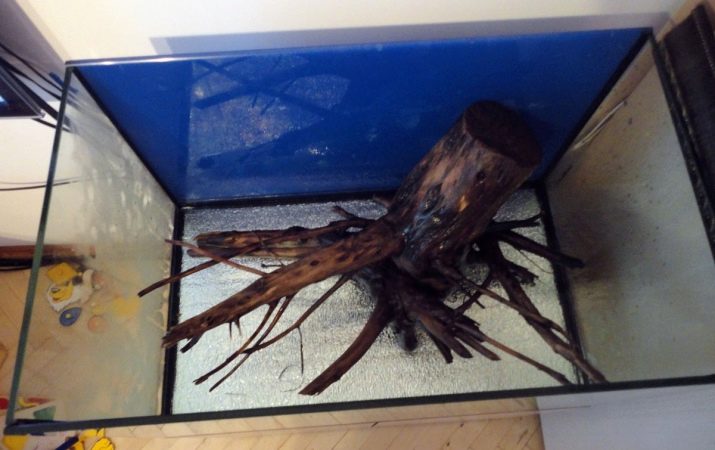
Preparation and processing
Water, as many aquarists know, is sensitive to even small changes. Therefore, all wood preparation procedures should be as delicate as possible. It is not enough to clear the tree of bark, it also needs to be boiled.
So you can get rid of all pathogens that, together with wood, can end up in the aquarium. Small insects and bacteria are killed by hot water. So that dry design elements do not pop up, wood needs to be boiled with salt - it becomes heavy in such water and sinks itself. You need to cook driftwood in an iron pan or bucket. For this, 1 g of water needs to be prepared 400 g of salt.
The main thing is cooking time. The full procedure takes about 10 hours, no less.
Water during this time, of course, evaporates, so the cooking process needs to be controlled, water should be added in a timely manner. You need to cook the tree that was bought at the pet store. It is impossible to prevent the appearance of branches in the aquarium that are intended for decoration of reptile dwellings: these branches are already treated with fungicides, which is harmful to fish.
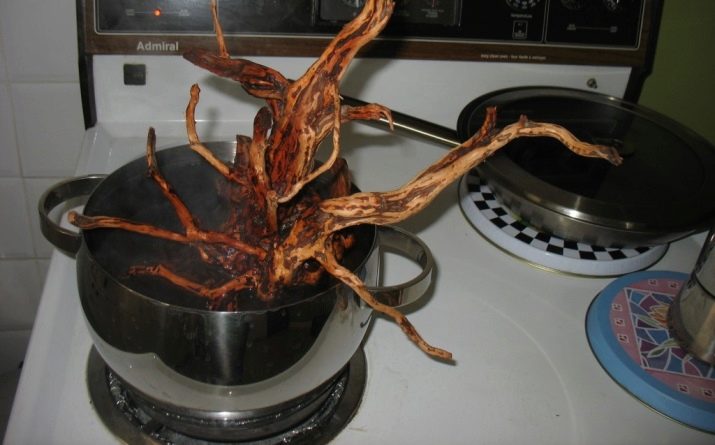
Features of the preparation of driftwood include several steps.
- After cooking, the tree purchased in the pet store should be transferred to a separate container with water, where it will be for two days. During this time, you will understand whether the tree stains water. If the liquid has colored slightly - everything is fine. But if water has become like saturated black tea, you should not use it for decoration.
- If you still decide to leave the driftwood, bother to soak it after cooking in water, and change this water every 5 hours. The process itself will take about two days. Continue to soak until fluid is steady light.
Not everyone cooks driftwood; some aquarists simply pour boiling water over them. Of course, cooking large elements is difficult. But a boiling water shower is not a solution to the problem: insufficient processing of the wood can cause harmful creatures to remain on it and subsequently harm the inhabitants of the aquarium.

The room in the water
The process of putting driftwood in water deserves special instructions. How to put it so that it does not pop up?
Never allow the volume snag branches to be fixed by abutting against the tank walls.
Wood that has been in water for a long time swells and changes in size. This is dangerous because the walls of the aquarium are being sold. Sometimes it is not possible to fix the snag in the water, as the tree remains dry. Even if you boil it well, it can remain dry inside. Therefore, without proper fixation, the snag will emerge.
The easiest way to quickly set the decoration in an aquarium is to fastening fishing line to the stone. Branches in principle, you can to fix in the tank with something heavy, for example, a stone. Some aquarists use suction cups to surely reliably place the decor in the chosen place.Oddly enough, it’s easier to put driftwood under a stone, since suction cups in water behave unpredictably.
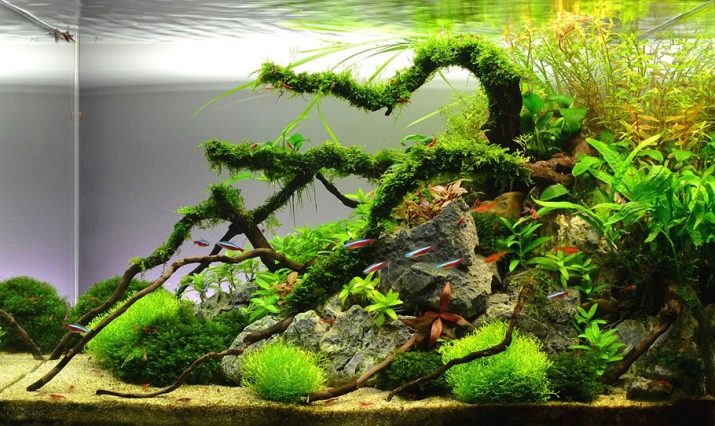
Additional decor
Snag, despite the fact that it is an independent decorative element, and may itself need decoration. Moss or vegetation that looks similar to moss looks especially beautiful on wood. It looks very attractive, natural.
It is very important to correctly fix the moss on the snag.
- It is fixed with a simple thread for sewing. It will rot over time, and the plant is already akin to wood.
- For greater strength, the thread is fixed with a fishing line. The fishing line will not rot and certainly surely fix the moss.
- There are also craftsmen who fix moss with superglue. But still, this option cannot be called the most successful, since toxins also get into the water with an adhesive composition.
The design of the aquarium with snags can be complemented by beautiful stones and, of course, algae.
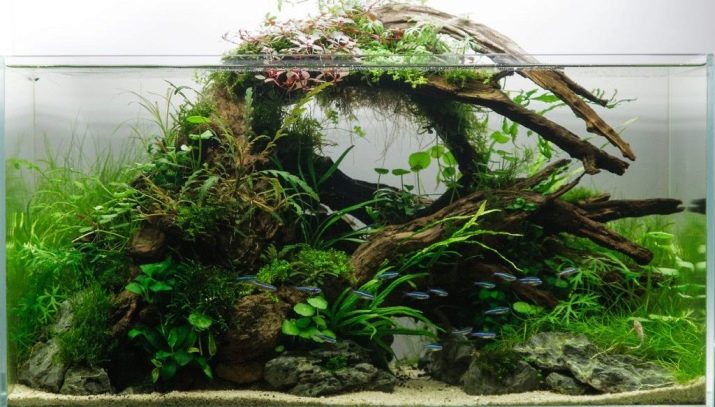
Possible problems
Often, even after good cooking, the wood begins to rot over time. This is due to the fact that live or rotted areas could remain in the snag. To prevent this problem, specialists use two methods: firing and paraffin.
In the first case, the snag needs to be slightly burned with a soldering iron over the entire surface (or at least at the “suspicious” ends). Then the tree is immersed in water for a couple of days, the charred zones are wiped with a napkin, and the soot is removed. In the case of paraffin, a thin layer is poured over the entire snag.
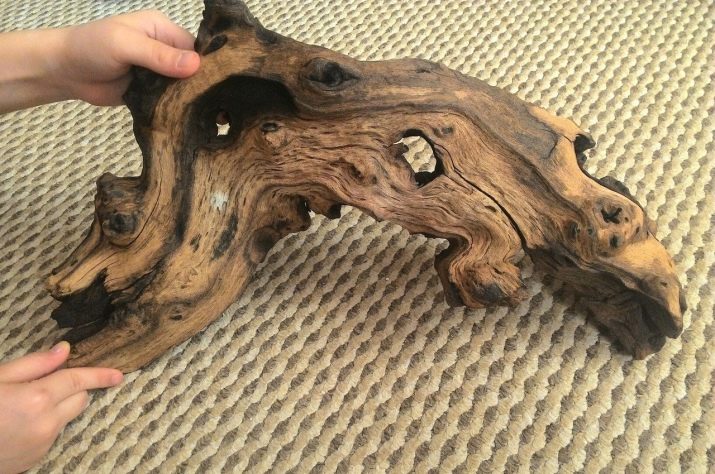
Consider what else could happen to a tree in an aquarium.
- Not drowning - therefore, the driftwood is not dry enough or cooked without salt. If the tree still pops up, press it with a stone or tie it with fishing line.
- Color water - it's time to soak until the water is clear. As mentioned above, this will take several days.
- The snag has turned yellow the water is cloudy, it smells of hydrogen sulfide in the tank - the wood rots. You need to get it and dry it (you can in the oven).
- Turned green - this color gives algae. It is necessary to reduce the length of daylight and lighting power.
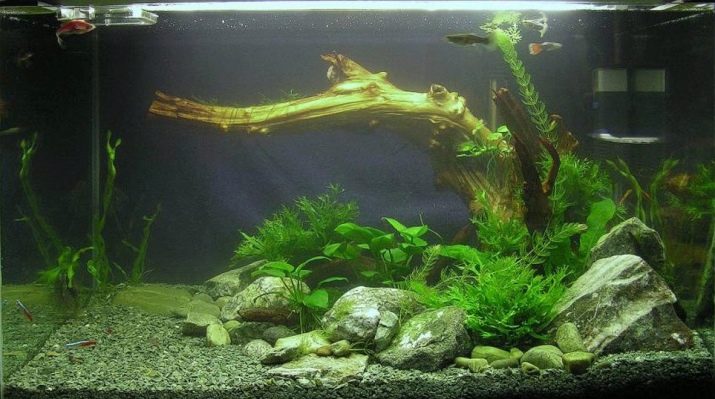
Some residents of the water world love to feast on the fibers of wood, and rightly so - it helps the digestive tract. For many fish, a tree is a natural part of living space, and such a purchase in a domestic pond will only benefit them. Adding driftwood to the aquarium optimizes the state of the biological environment, decorates a container with water, and allows you to try on the role of an aqua designer.
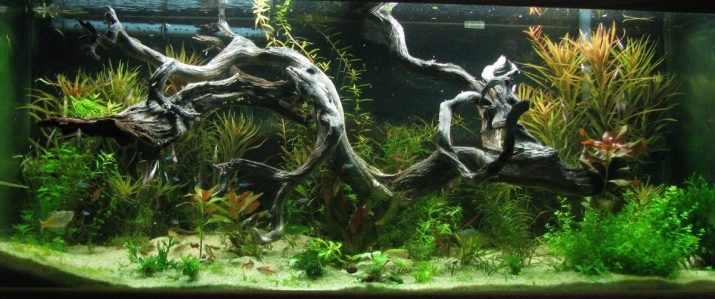
An overview of snags for the aquarium can be found in the next video.
